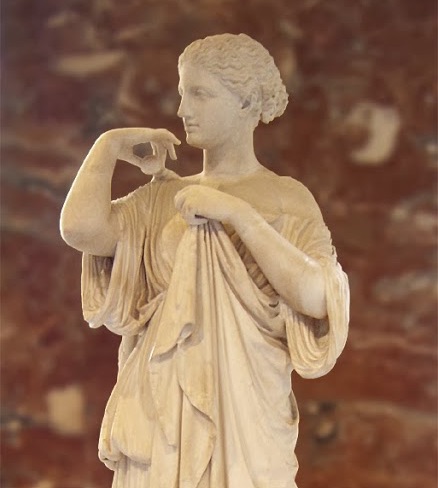The clothing of the women of Ancient Greece from the fifth century B.C.E., to the fourth century B.C.E., changed as the time periods changed. Changes in fashion are important, because these changes reflect some of the changes in society. As with all societies throughout history, as years go by, different fashions come and they go. This was exactly the same with the ancient Greek women in the fifth century. The different clothing styles of this century changed with events and with innovations.
Himation
The himation was made from a rectangle of woven wool. “It started as outdoor wear, but, when light material came into style, the himation was worn at any time,” states Payne. (83) It first was used as a cloak but, as the century passed, it was draped more elaborately and it was ten to twelve feet longer.

Peplos
Another garment worn by the Doric women was the peplos. It was also worn in the fifth century B.C.E. Kohler says, “[The peplos] has a piece of woolen material, about 3 meters wide and of a length equal to the height of the wearer, and was folded at the upper extremity to form first a narrow and then a wider shawl or plaid. The material was brought through beneath the left arm and fastened with tapes on the right shoulder to leave a board peak in front and behind.” (100).
Common material Patterns of the Peplos included:
- checks
- wavy lines
- stripes
- flowered designs
The peplos was tubular in shape, and the upper edge was turned down at the waist. The peplos was put over the head and was made to fit closely at the shoulder with fasteners. The arms were left bare. It was held at the waist with a girdle. The lower edge was finished with a braid. The peplos was open at the right side and hung in folds from the shoulder. In time, the shawl, or plaid, was so wide that it reached to the hip. It was tied with tapes on both shoulders.

Chiton
In the early fifth century, after the Persian Invasion, the native Doric chiton came into style. Examples of this style include the dress of the Porch Maidens, or Caryatids of the Erectheum, and the Dancing Girls of Herculaeum. The Doric chiton came directly from the style of the peplos.
Payne states, “The Doric chiton was folded and worn in the same manner as the peplos, but was of larger dimensions.” (80) It was about twice the width from elbow to elbow with arms bent and lifts to a horizontal position. “The Doric chiton consisted of two pieces of rectangular cloth equal to the height of the wearer,” says Kohler. (99) It was shown either closed or open down the right side. It was worn closed in Corinth and Attica. The chiton was made of fine pleated linen.
Differences between the Doric and Ionic Chiton
The basic form of the Chiton is similar to the one worn by men, but longer. It is essentially a large rectangle draped around the body and pinned at the shoulders to form the neck hole. Several pins could be used at the top of the cloth from the shoulder to the wrist to form a sort of sleeve.

The whole thing is held together by a belt or sash at the waist. Belts or sashes can also be worn around the hips, under the breasts, or criss-crossed between the breasts.
The Peplos is very similar, but has a larger fold at the top, sometimes going down to the waist or hips.
One of the main differences between the peplos and the Doric chiton was the length of the over fold, which was called the apotyga. On the peplos, it ended well above the waistline. However, on the Doric chiton it was worn longer. With the Doric chiton, the waistline declined so that the lower edge of the blouse, which was formed by pulling the excess length above the girdle, could reach the hipbones. This portion of the blouse was called the kolpos.
In the middle of the fifth century, when the Persian Wars ended, the Ionic chiton came into style. One of the most beautiful versions of the Ionic chiton can be found on the Birth of Aphrodite, which is a Bas-Relief, currently located in the Terme Museum in Rome. This is dated between 470 and 460 B.C.E. “The sheerness and draping of the linen are wonderfully expressed,” says Payne. (81)

Colours
Colours also played a big role in ancient Greek women’s fashion. Different colours symbolized different things. For example, a dark veil was a sign of mourning. In the book The Iliad, Homer writes that Thetis wears an indigo veil because she is in mourning because she knows that Achilles, her son, is going to die. Homer writes, “The radiant queen of the sea-nymphs seized a veil, blue-black (no darker) robe in all the ocean depths.” (591) Evans states, “Dark blue is seldom applied to garments, yet it is scarcely likely that the colour was unknown to the Greeks.” (100).
Chitons and peploi could be plain, but many examples on pottery are highly decorated with strips and patterns, and a variety of colours.
Finally, the diplax is a very long but narrow stole that would have been pinned halfway along, at the shoulder, and draped diagonally across the body, sometimes with a drawstring to pleat it.
The ends would have hung in folds from the shoulder.

In 500 B.C.E., to 400 B.C.E., ancient Greek women wore many fashions. Their clothing became more elaborate and more detailed as the century passed. The colors became brighter, and new styles were developed. The changing of fashion for the Greek women relates to all societies. As time goes on, fashion everywhere changes, just as it did for ancient Greek women.











